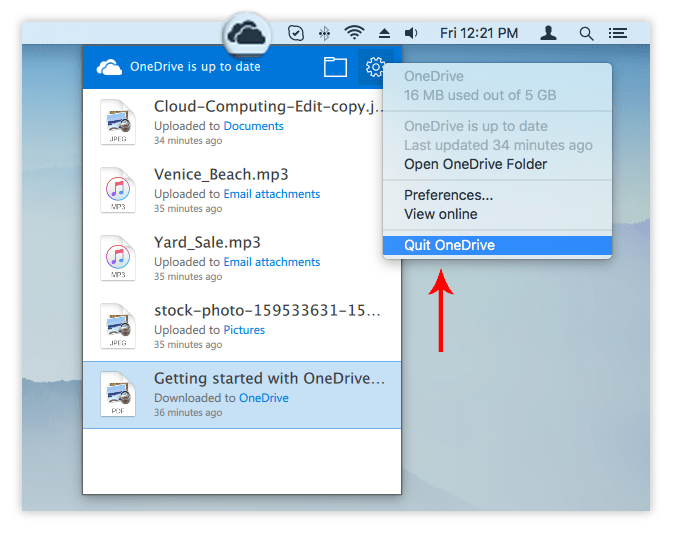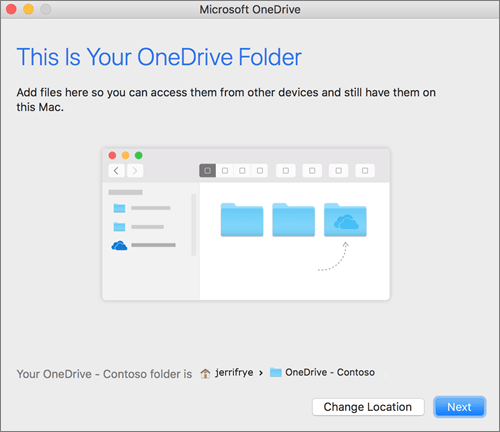Disable Onedrive Office 2016 For Mac
Please note: some of the information in this post is now out of date Today I was working on a word document and wanted to save it to my Office 365 work account. It did not appear in the Save As list of accounts and when I tried to add it I received this error: “You’ve connected too many services.
Please remove some connections before adding additional services.” However, it wasn’t obvious to me how I could remove these services. Figure 2: Error Too Many Services First, let me explain how you can add a new Save As location in Office 2016. In Figure 1 to the right, you will see the options available when you click Save As in the left navigation. The image displays the services I have added; your list will be different. To add a new Save As location:.


Click Add a Place. Next it will ask you for your password. If you had previously chosen (A) Office 365 SharePoint, and have both a personal and a work account using the same email address, you will also see a pop up asking you to choose a work or personal account. This is shown in Figure 4 below. Figure 4: Choose Work or Personal Account. Now the account appears in the Save As options Let’s go back to our original problem, how do you remove services / Save As locations? I tried many options: right clicking, hitting delete, none worked.
This is because you have to visit another menu to change this list! How to remove Save As locations:. In the left hand menu, click Account.
See image to the right. You now can see your list of Connected Services, with the option to remove those that you do not want in your Save As list That’s it! Now you can easily save files to your favorite cloud locations. But, what if you do not want to save to a cloud location? Maybe your company doesn’t use Office 365 or you would like to save to your hard drive.
How to Save to a Non-Cloud Location:. In Figure 5, Click #3: Options. In Figure 6 Below, Click Save on the left menu. Next, check the box Save to Computer by default. Chose a different Default local file location, which is optional Figure 6: Save to Local Computer.

Microsoft encourages users to save their work in OneDrive by making it the default save location in Office 2013. This is handy if you regularly use OneDrive to backup and sync your files, but for those who use online services, or those who prefer to save their files locally, it’s annoying and inefficient to have to deselect OneDrive each time you try to save a file, and instead manually navigate to your save location of choice.
Thankfully, this problem can be easily solved by setting a new default save location in Office 2013 settings. Note that the steps described here are unique to each major Office app, so you’ll need to repeat these steps in Word, Excel, and PowerPoint if you want all three apps to save to the same new default location. However, by maintaining separate settings for each app, it makes it easy to set different default save locations depending on your workflow; for example, saving all Word documents to your local user documents folder, and saving all Excel files to a network location shared with the Accounting department. For our screenshots, we’re using Word 2013, but the steps are the same for Excel and PowerPoint.
First, launch your Office 2013 app and open an existing document, or create a new document. With the document open and viewable, find and click File in the top-left portion of the window. This will launch what Microsoft calls the Office ““, which lets you open existing documents, create new documents, and access important feature such as print and export settings.
Uninstall Onedrive For Mac
Locate the Options button at the bottom of the list on the left. In the Options window, select Save from the list of options on the left.
This reveals a number of save-related settings and preferences. To remove OneDrive as the default save location, find and check the box labeled Save to Computer by Default. This will tell Word, Excel, or PowerPoint that you want your documents to be saved to your computer, or a network-attached volume, instead of an online service like OneDrive.
The default save location is your user Documents folder. If the user Documents folder works for you, then you’re all set. If, however, you’d prefer to set a custom save location, click the Browse button next to the Default Local File Location box and navigate to the desired location on your PC.
When you’ve made your selection, click OK to save it, and OK again to close the Options window. You’ll now need to quit and restart Word, Excel, or PowerPoint in order for the change to take effect, so manually save any open documents and close your Office apps. After reopening Word, Excel, or PowerPoint, any new save commands will select the location on your PC that you identified in the Options window by default. Of course, you can still save to OneDrive or any other location on your PC, but you’ll need to manually navigate to these locations in the Office Save window. Therefore, to maximize efficiency, make sure you set your most-used save location in Office 2013 settings, ensuring that, most of the time, all you have to do is click “Save” to place your document in its intended location. Want news and tips from TekRevue delivered directly to your inbox? Sign up for the TekRevue Weekly Digest using the box below. Get tips, reviews, news, and giveaways reserved exclusively for subscribers.